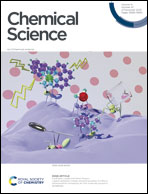Engineering TADF, mechanochromism, and second harmonic up-conversion properties in regioisomeric substitution space†
Abstract
This research article explores the distinct TADF efficiency of three donor–acceptor based regio-isomers: DPAOCN (ortho-isomer), DPAMCN (meta-isomer), and DPAPCN (para-isomer). DPAPCN exhibits maximum TADF efficiency in both solution and solid-state with an impressive reverse inter-system crossing (RISC) rate of ∼106 s−1; the underlying cause being the minimum singlet-triplet splitting energy or ΔEST and maximum SOC (spin–orbit coupling) between the S1 & T1 states. Apart from TADF, differences in crystal packing of the regio-isomers result in intriguing bulk phase properties. DPAOCN, with its non-centrosymmetric P212121 space group and substantial crystal void volume, exhibits reversible tri-color mechanochromic luminescence behavior, while the meta and para isomers, due to their centrosymmetric packing and diminished crystal void volume, remain inert to mechanical pressure. Expanding the horizon of possibilities, the non-centrosymmetric nature of ortho-isomer further renders it an excellent SHG material, with a χ(2) value of 0.19 pm V−1 at 1220 nm and a laser-induced damage threshold (LIDT) value of 13.27 GW cm−2. Overall, a comprehensive investigation into the regio-isomers has been carried out, encompassing their TADF, SHG, and mechanochromic luminescent properties.

- This article is part of the themed collection: #MyFirstChemSci 2023


 Please wait while we load your content...
Please wait while we load your content...